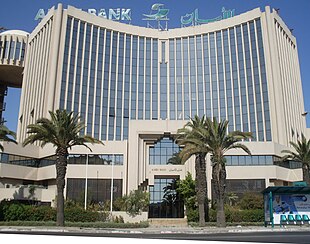
Back اقتصاد تونس Arabic Economía de Tunicia AST Эканоміка Туніса Byelorussian Economia de Tunísia Catalan Wirtschaft Tunesiens German Economía de Túnez Spanish اقتصاد تونس Persian Économie de la Tunisie French Economía de Tunisia Galician כלכלת תוניסיה HE
This article has multiple issues. Please help improve it or discuss these issues on the talk page. (Learn how and when to remove these template messages)
|
 Amen Bank, one of the biggest banks in the country | |
| Currency | Tunisian dinar (TND, د.ت) |
|---|---|
| calendar year | |
Trade organisations | African Union, AfCFTA (signed), WTO, COMESA, CEN-SAD, AMU |
Country group |
|
| Statistics | |
| Population | |
| GDP | |
| GDP rank | |
GDP growth |
|
GDP per capita | |
GDP per capita rank | |
GDP by sector |
|
Population below poverty line | |
| 32.8 medium (2015)[10] | |
Labour force | |
Labour force by occupation |
|
| Unemployment | |
| $360 monthly (2023)[15] | |
Main industries | petroleum, mining (particularly phosphate, iron ore), tourism, textile, footwear, agriculture, beverages, olive oil |
| External | |
| Exports | |
Export goods | clothing, semi-finished goods and textiles, agricultural products, mechanical goods, phosphates and chemicals, hydrocarbons, electrical equipment |
Main export partners |
|
| Imports | |
Import goods | textiles, machinery and equipment, hydrocarbons, chemicals, foodstuffs |
Main import partners | |
FDI stock | |
Gross external debt | |
| Public finances | |
| −5.8% (of GDP) (2017 est.)[6] | |
| Revenues | 10.957 billion (2022 est.)[6] |
| Expenses | 12.523 billion (2022 est.)[6] |
All values, unless otherwise stated, are in US dollars. | |
The economy of Tunisia is in the process of being liberalized after decades of heavy state direction and participation in the country's economy. Prudent economic and fiscal planning has resulted in moderate but sustained growth for over a decade. Tunisia's economic growth historically has depended on oil, phosphates, agri-food products, car parts manufacturing, and tourism. In the World Economic Forum Global Competitiveness Report for 2015–2016, Tunisia ranks in 92nd place.[21]
The year 2015 was marked by terrorist attacks in Tunisia which are likely to affect economic growth, especially in tourism, one of the main sectors.[22]
- ^ "World Economic Outlook Database, April 2019". IMF.org. International Monetary Fund. Retrieved 29 September 2019.
- ^ "World Bank Country and Lending Groups". datahelpdesk.worldbank.org. World Bank. Retrieved 29 September 2019.
- ^ locations=TN&name_desc=false "Population, total - Tunisia". data.worldbank.org. World Bank. Retrieved 3 October 2019.
{{cite web}}: Check|url=value (help) - ^ a b c d e "World Economic Outlook Database, October 2019". IMF.org. Retrieved 16 November 2019.
- ^ Rabah, Arezki; Daniel, Lederman; Amani, Abou Harb; Nelly, El-Mallakh; Yuting, Fan; Asif, Islam; Ha, Nguyen; Marwane, Zouaidi (9 April 2020). Middle East and North Africa Economic Update, April 2020 : How Transparency Can Help the Middle East and North Africa. World Bank. p. 10. ISBN 9781464815614. Retrieved 10 April 2020.
{{cite book}}:|website=ignored (help) - ^ a b c d e f g h i j "The World Factbook". CIA.gov. Central Intelligence Agency. Retrieved 12 May 2019.
- ^ "Tunisia - inflation rate 1986-2022".
- ^ "Poverty headcount ratio at national poverty lines (% of population) - Tunisia". data.worldbank.org. World Bank. Retrieved 20 March 2020.
- ^ "Poverty headcount ratio at $5.50 a day (2011 PPP) (% of population) - Tunisia". data.worldbank.org. World Bank. Retrieved 20 March 2020.
- ^ "GINI index (World Bank estimate)". data.worldbank.org. World Bank. Retrieved 12 May 2019.
- ^ "Human Development Index (HDI)" (PDF). hdr.undp.org. HDRO (Human Development Report Office) United Nations Development Programme. Retrieved 22 November 2022.
- ^ "Inequality-adjusted Human Development Index (IHDI)". hdr.undp.org. HDRO (Human Development Report Office) United Nations Development Programme. Retrieved 22 November 2022.
- ^ "Labor force, total - Tunisia". data.worldbank.org. World Bank. Retrieved 27 November 2019.
- ^ "Employment to population ratio, 15+, total (%) (national estimate) - Tunisia". data.worldbank.org. World Bank.
{{cite web}}: Missing or empty|url=(help) - ^ "Rankings by Country of Average Monthly Net Salary (After Tax) (Salaries And Financing)". www.numbeo.com.
- ^ "Tunisia Exports 1965-2022".
- ^ a b "Foreign trade partners of Tunisia". The Observatory of Economic Complexity. Retrieved 18 June 2021.
- ^ "Tunisia Trade | WITS | Text".
- ^ "Sovereigns rating list". Standard & Poor's. Retrieved 26 May 2011.
- ^ a b c Rogers, Simon; Sedghi, Ami (15 April 2011). "How Fitch, Moody's and S&P rate each country's credit rating". The Guardian. Retrieved 28 May 2011.
- ^ "Competitiveness Rankings".
- ^ Solutions, EIU Digital. "Tunisia Economy, Politics and GDP Growth Summary - The Economist Intelligence Unit". country.eiu.com.